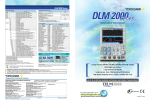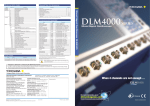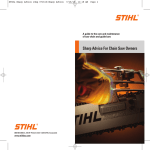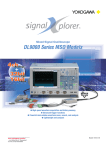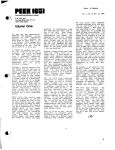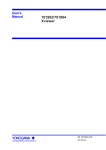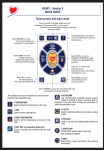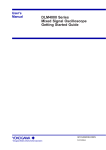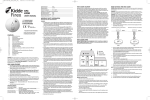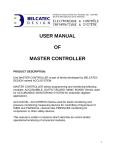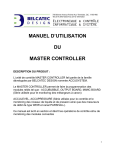Download DLM 2000 - Yokogawa
Transcript
DLM 2000 Series Mixed Signal Oscilloscope Lineup includes 200 MHz, 350 MHz, 500 MHz bandwidth models Lightweight and compact Large 8.4-inch LCD display Long memory: Up to 125M points (with /M2 option) High speed sampling: Up to 2.5 GS/s (1.25 GS/s with 4 ch) -Year ear Warranty Warrant Bulletin 7101-00E Flexible inputs and flexible performance Easy-to-Use & Easy-to-See Signal observation on 4 channels or more... Easy to use. Portrait body + large screen makes display easy to see. We elevated the large (8.4-inch) LCD screen up into the line of sight. Also, the portrait format saves space on the desk or test bench. A compact personal oscilloscope designed for easy viewing and ease of use. Flexible MSO Input - Capture a mixed signals of analog and logic signals - Measured values can be accurately read on the 0.1 div sub grid display. Four channels is not sufficient to view the functioning of digital control circuits. The DLM2000 series converts 4 ch of analog input to 8-bit logic, and functions as a 3 ch analog + 8-bit logic MSO (mixed signal oscilloscope). 3 ch analog + 8-bit logic The performance of up to 11 inputs by converting to logic Fast data processing with ScopeCORE Using logic input, up to 11 input signals can be observed simultaneously as 3 ch of analog and 8-bit logic. It is not only possible to use logic input for observation of data and control signals, or as a trigger source, but also for logic 2 input analysis of I C and SPI serial busses. With our proprietary ScopeCORE fast data processing IC, real time display is possible even when simultaneously measuring multichannel signals of 11 inputs. Logic probe for the DLM2000 Large screen in a compact body Footprint is approximately 2/3 the size of an 81/2 × 11 sheet of paper (depth of approximately 8 ) Horizontal Postion and Scale Knob Dedicated Zoom Keys Four-Direction Selector Button Select key moves the cursor up/down/left/right ScopeCORE fast data processing IC DLM2000 Series Lineup Model Item Jog Shuttle and Rotary Knob Logic input connector Vertical Postion and Scale Trigger Control Keys and Level Knob DLM2022 710105 DLM2032 710115 Analog input channels 2 Logic input - Maximum sampling rate Frequency characteristics Maximum record length DLM2052 710125 DLM2024 710110 DLM2034 710120 DLM2054 710130 4* 8bit 2.5 GS/s (interleave ON) 200 MHz 350 MHz 500 MHz 62.5 Mpoints (Single measurement, memory length:/M1S, interleave ON) 200 MHz 350 MHz 500 MHz 125 Mpoints (Single measurement, memory length: /M2, interleave ON) * Or 3 channels when using logic input. 02 03 Sophisticated waveform acquisition engine With long memory and the History function, you'll never miss an historical waveform. A variety of trigger functions reliably capture the waveforms you want. Large capacity (125 Mpoint) memory enables long-duration measurements For taking 2 ch measurements in Single mode, you can add the /M2 memory expansion option giving you up to 125 Mpoints of large memory capacity. 10,000 Hz signals can be recorded for up to 5,000 seconds. Even at a sampling rate of 1.25 GS/s, waveforms down to 0.1 seconds can be captured. Continuous Measurement 2 ch, 4 ch same 1.25 Mpoints 6.25 Mpoints 12.5 Mpoints Standard /M1, /M1S memory option /M2 memory option Single-Shot Measurement With 4 ch (With 2ch for DLM20x2) With 2 ch (With 1ch for DLM20x2) 12.5 Mpoints 6.25 Mpoints 62.5 Mpoints 25 Mpoints 125 Mpoints 62.5 Mpoints Trigger Function capturing combined analog/digital complex waveforms The DLM2000 series ser ies comes with a var vvariety ariety iety of easy-to-configure triggers triggers combining analog and logic inputs such as edge, edge, enhanced, and B triggers tr triggers. iggers. Edge trigger Enhanced triggers Note)The /M1, /M2 memory expansion options are only available on 4ch models. The /M1S option is only available on 2ch models. Edge OR Edge (qualified) You can replay waveforms later on, so you'll never miss an abnormal waveform HISTORY - History Function With the DLM2000 series, up to 20,000 previously captured waveforms can be saved in the acquisition memory. With the History function, you can display just one or all of the previously captured waveforms (history waveforms) on screen. You can also perform cursor measurement, computation, and other operations on history waveforms. Using the History function, you can analyze rarely-occurring abnormal signals. Edge Trigger function example xample A to B(n) trigger: Example:Trigger on the 7th edge of signal on B. This is effective for measurements with shifted timing, such as non-standard video signal vertical/horizontal periods or motor reference position pulses and drive pulses. Input signal A Input signal B Trigger State Pulse width State width Abnormal signal Serial: (optional) CAN/LIN/UART/I2C/SPI : (standard) user-defined Waveform history TV : NTSC/PAL/SDTV/ HDTV/user defined Serial pattern trigger (user defined): Example :Trigger on an arbitrarily set pattern of up to 128 bits. This is effective for detecting ID/Data and other portions of proprietary communication formats. HHHH-LHLH-LLLL (Arbitrary pattern) Trigger Dual pulse trigger: Example:Trigger on a combination of CAN and LIN bus triggers. I2C + SPI bus triggers, and other combinations are possible. Trigger when either LIN or CAN bus signal conditions become true Input signal A CAN B triggers A Delay B A to B(n) 04 History search function Replay function You can search the up to 20,000 previously captured waveforms for history waveforms that meet certain conditions. You can perform cursor measurement and other analyses on the found waveforms. Waveforms can be displayed in order, one at a time, by using the rotary knob. With the Replay function, history waveforms can be automatically played back, paused, fast-forwarded, and rewound. Input signal B LIN LIN CAN Dual bus (combination trigger of 2 serial busses) 05 Capture & Display Zoom and Search Functions DLM 2000 Series Real time filter with optimum noise reduction supports a wide range of frequencies (from 8 kHz to 200 MHz) The DLM2000 series has two types of filters, one processed at the input circuit and one based on MATH functions. These filters are effective for rejecting unwanted signals, allowing observation of only the desired bandwidths. Real time filters Computed digital filters Each channel has 14 low pass filters available from 8 kHz to 200 MHz. Waveforms of limited bandwidths are stored in internal memory. The input waveform can be filtered using an IIR filter, which is a MATH function. Filtered waveforms can be displayed at the same time as the input waveform for comparison. You can select low pass or high pass filters. Cutoff frequencies : 200 MHz, 100 MHz, 20 MHz, 10 MHz, 5 MHz, 2 MHz, 1 MHz, 500 kHz, 250 kHz, 125 kHz, 62.5 kHz, 32 kHz, 16 kHz, and 8 kHz Cutoff frequency setting range : 0.01 Hz to 500 MHz Input signal Computed waveform Processing with built-in filters Filtering of a PWM waveform using computation Zooms into two different points — Waveform zoom and search functions — Zoom two locations simultaneously Because the DLM2000 series lets you set zoom factors independently, you can display two zoomed waveforms with different time axis scales at the same time. Also, using the Auto Scroll function, you can automatically scroll waveforms captured in long memory and change the zoomed location. With Auto Scroll you can choose forward, backward, fast-forward, scroll speed, and other control options. Dedicated Zoom keys Zoom1 Zoom2 Auto Scroll menu Large capacity memory gives you a variety of waveform search functions. Two types of waveform searching: Normally, searching for data takes time and costs money, and long memory is useless without functions for extracting desired data from a large capacity memory. That's why the DLM2000 series does not simply offer long memory, it also provides powerful waveform search functions. Searching for data in a single screen: the Zoom Search function Searching for history waveforms: the History Search function This function searches captured waveforms in the long memory and displays waveforms that meet the search criteria in the zoom area. The locations of the found waveforms are marked on screen ( shows the current location). Criteria can be specified for extracting desired waveforms from up to 20,000 previously captured waveforms. Criterion extraction • Waveform search criteria Edge, edge (with conditions), state pattern, pulse width, state width, serial bus (only on models with the serial bus analysis option) Zone created from measured waveforms Search results marked Waveform search using edge criterion 06 Place square zone and search Searching for waveforms in zones created by moving measured waveforms up/down/left/right. Search for waveforms that pass through/do not pass through a rectangular zone placed on screen. Useful Functions Fastest and most capable analysis DLM 2000 Series Displays trends of peak-to-peak or pulse width per cycle — Measure function and statistics — — Trend and histogram displays — Twenty-eight waveform parameters are included such as: maximum, minimum, peak-to-peak, pulse width, period, frequency, rise/fall time, and duty ratio. Automated measurement can be performed using up to 20 of these waveform parameters. Also, waveform parameters can be measured repeatedly, and the statistical values displayed (mean, maximum, minimum, standard deviation, etc.). Waveform parameters such as period, pulse width, and amplitude can be measured repeatedly and displayed in graphs. In a single screen you can observe period-byperiod fluctuations, compute amplitudes every screen using multiple waveforms, and display amplitudes Trend display of waveform parameters as trends. You can also Histogram display using the time axis display histograms referencing the voltage or time axis using values from repeated automated measurement of waveform parameters. Measures voltage/time differences automatically Analyzes frequency spectrums — Cursor Measurement — — FFT analysis — Cursors can be placed on the displayed waveform from signal data, and various measurement values at the intersection of the cursor and waveform can be displayed. There are six types of cursor; ∆T, ∆V, ∆T& ∆V, Marker, Degree Cursor. Up to 2 FFT analyses can be performed simultaneously. FFT can be performed on computed waveforms in addition to the actual waveforms on CH1 to CH4. Analysis can be performaed of the frequency components of waveforms filtered for limited bandwidth, of frequency for changes in period of rotary objects, and other phenomena. Simultaneous level and time difference measurement with the ∆T&∆V cursor Keeps waveforms with one push — Snapshot — By pressing the SNAPSHOT key to the lower right of the screen, you can freeze a white trace of the currently displayed waveform on the screen. You can press the key repeatedly and conveniently leave traces for comparing multiple waveforms. Also, snapshot data recorded on screen can be saved or loaded as files, and can be recalled for use as reference waveforms when making comparisons. FFT analysis Displays stored files in thumbnail format — Thumbnails of saved files — "SNAP SHOT"key Using snapshots (white waveforms) Has a GO/NO-GO function Abnormal waveform detected — Action on trigger — GO/NO-GO can be determined using trigger conditions, zone waveforms, measurement parameters, and other criteria. For NO-GO, actions can be carried out at the same time such as sounding a buzzer, saving the current waveform, or sending notification to a designated e-mail address. Waveforms in which an abnormality occurred can be saved for confirmation and analysis of the phenomena at a later time. Thumbnails of waveform data, waveform image data, and WaveZone files can be displayed. The image and file names are shown so that you can view screen image contents while copying or deleting files. In addition to normalsized screens, you can even save wide images that have been zoomed along the time axis. Thumbnails of saved files Zoomed (2x) long image file Can check functions with graphical online help — Graphical online help — Action specified for NO-GO Buzzer Output to printer Save waveform E-mail data file transmission You can view detailed graphical explanations of the oscilloscope's functions by pressing the "?" key in the lower left of the screen. This lets you get help on functions and operations on screen without having to consult the user's manual. 07 Solutions of the DLM2000 Analysis Applications Serial analysis function options DLM 2000 Series (/F1, /F2, /F3, /F4) 2 - UART/CAN/LIN/I C/SPI- Inputs supported for serial bus analysis Triggers for UART, CAN, LIN, I2C, and SPI bus signals are supported along with decode display analysis (serial bus analysis option only on 4 ch models). Logic input can also be used for serial buses (excluding CAN and LIN). Analog input Logic input I2 C Yes Yes SPI Yes Yes UART Yes Yes LIN Yes NA CAN Yes NA Simultaneous analyses of different busses: Two busses can be analyzed simultaneously. Waveforms and analysis results from busses with different speeds can be displayed in individual Zoom screens with different scales. A wealth of trigger functions: A wide variety of trigger conditions can be set, such as ID/Data trigger combinations and combinations of serial bus triggers with normal edge triggers. Simultaneous analyses of I2C and SPI Simultaneous analyses of CAN and LIN Accessories PBDH1000 differential probe (model 701924) 1.0 GHz bandwidth 1 MΩ, approximately 1.1 pF Maximum differential input voltage range: ± 25 V Differential probe (model 701920) DC to 500 MHz bandwidth 100 kΩ, approximately 2.5 pF Maximum differential input voltage range: ±12V Power supply analysis option (/G4) Dedicated power supply analysis options are available (4 ch models only) for switching loss, joule integral (i2t), SOA (safe operating area) analysis, harmonic analysis of power supply current based on EN61000-3-2, and other operations. Switching loss analysis Harmonic analysis of power supply current based on EN61000-3-2 Voltage and current waveforms can be input to the 62.5 MW (max.) long memory (/M2 models) for computation of switching loss (V(t) X i(t)). A wide variety of switching loss analyses are supported, including turnon/off loss calculation, loss including continuity loss, and loss over long cycles (50 Hz/60 Hz). Harmonics determined by the IEC standard that are generated by the target device can be judged for each applicable class (classes A-D). Bar graphs and lists can be displayed for comparing harmonic current limit values with values calculated from actually measured signals. Harmonic current graph display Related Accessories 700924 Differential probe DC to 100 MHz 1000 Vrms/ ± 1400 V 08 701928/701929 Current probe DC to 100 MHz(701928) DC to 50 MHz(701929) 30 Arms 701935 Deskew correction signal source Connectivity & Software DLM 2000 Series Broad Connectivity and Easier Control Probe power terminal (optional) Power supply output terminal for current probes (701930 and 701931) and differential probes (701920, 701921, 701922, 700924, 700925, and 701926). GP-IB connection terminal (optional) Enables control from a PC. External trigger input Lets you input a trigger signal separately from the input signal. Ethernet (optional) Supports 1000BASE-T, 100BASE-TX, 10BASE-T GO/NO-GO I/O terminal Using the GO/NO-GO function, you can input a timing signal for judging a waveform and output the result as a TTL level signal. RGB video signal output terminal You can output an image signal and check the waveform on an external monitor. Trigger output Outputs a CMOS 3.3V level trigger signal. USB-PC connection terminal Enables control from a PC. USB peripheral connection terminal Supports USB storage, USB keyboards, USB printers. 1000BASE-T/100BASE-TX/ 10BASE-T compliant adapters (hubs and routers) Sends waveform, screen, and settings data Remote control Mail transmission (GO/NO-GO action) Sends waveform, screen, and settings data Remote control Ethernet (/C10, /C11 options) USB (standard on rear panel) Internal storage (/C8 option) USB memory Software USB printer USB keyboard For details on accessory software, visit https://y-link.yokogawa.com/YL000.po Also, you can download free software and trial versions of retail software from this site. Xviewer (701992, sold separately) DL series library (freeware) Xviewer is software for use on a PC. It can be used for display, analysis, and conversion to ASCII of binary waveform data using waveforms captured by the DLM2000 series. By adding the MATH option, you can enter user expressions for performing waveform computations. FFT of up to 2 Mwords can be performed. This is an API that enables you to control a DL or send data from a DL using an external program. The API is offered in the form of a DLL that can be called from a program controlled by the user. 09 Main Specification Models Model name Frequency bandwidth DLM2022 (710105) 200MHz DLM2032 (710115) 350MHz DLM2052 (710125) 500MHz DLM2024 (710110) 200MHz DLM2034 (710120) 350MHz DLM2054 (710130) 500MHz Basic Specifications Analog Signal input Input channels Analog input Input coupling setting Input impedance Voltage axis sensitivity setting range Max. input voltage Max. DC offset setting range Input terminal 2 analog channels 4 analog channels / 3 analog channels + 8bit logic Analog input 1 MΩ 50 Ω 1 MΩ 50 Ω 1 MΩ 50 Ω 1 DC accuracy* 1 Offset voltage accuracy* 2 mV to 50mV/div 100 mV to 500 mV/div 1 V to 10 V/div Max. sample rate Triggers Trigger modes Trigger type, trigger source A triggers 1.25GS/s (interleave mode off) 2.5GS/s (interleave mode on) DLM20x2: CH1, CH2 DLM20x4: CH1 to CH4 (CH1 to CH3 when using logic input) AC, DC, DC50 Ω, GND 1 MΩ ±1.0%, approximately 20 pF 50 Ω ±1.0% (VSWR 1.4 or less, DC to 500MHz) 2 mV/div to 10 V/div (steps of 1-2-5) 2 mV/div to 500 mV/div (steps of 1-2-5) 150 Vrms (CAT I) Must not exceed 5 Vrms or 10 Vpeak ±1V (2 mV/div to 50 mV/div) ±10V (100 mV/div to 500 mV/div) ±100V (1 V/div to 10 V/div) ±1V (2 mV/div to 50 mV/div) ±5V (100 mV/div to 500 mV/div) ±(1.5% of 8 div + offset voltage accuracy) ±(1% of setting +0.2 mV) ±(1% of setting + 2 mV) ±(1% of setting + 20 mV) AB triggers Trigger level setting range CH1 to CH4 Trigger level setting resolution CH1 to CH4 Trigger level accuracy CH1 to CH4 Window Comparator Display Display 8.4-inch TFT color liquid crystal display 1024 x 768 (XGA) Functions Waveform acquisition modes High Resolution mode Frequency characteristics (-3 dB attenuation when inputting a sinewave of amplitude ±3div)* * DLM202x DLM203x DLM205x 1 MΩ(when using passive probe) 100 mV to 100 V/div DC to 200 MHz DC to 350 MHz DC to 500 MHz 20 mV to 50 mV/div DC to 150 MHz DC to 300 MHz DC to 400 MHz 50 Ω 10 mV to 10 V/div DC to 200 MHz DC to 350 MHz DC to 500 MHz 2 mV to 5 mV/div DC to 150 MHz DC to 300 MHz DC to 400 MHz 1 2 Isolation between channels 3 Residual noise level* A/D resolution Bandwidth limit Maximum sample rate Real time sampling mode Interleave OFF Interleave ON Repetitive sampling mode Maximum record length 2 ch model (Standard) 2 ch model (/M1S) 4 ch model (Standard) 4 ch model (/M1) 4 ch model (/M2) Ch-to-Ch deskew Time axis setting range Time base accuracy 4 Max. acquisition rate* Dead time in N Single mode Logic Signal Input (4 ch model only) Number of inputs 1 Maximum toggle frequency* Compatible probes Min. input voltage Input range Max. nondestructive input voltage Threshold level setting range Input impedance Maximum sampling rate Maximum record length 10 Standard /M1, /M1S option /M2 option -34 dB@ analog bandwidth (typical value) The larger of 0.4 mV rms or 0.05 div rms (typical value) 8bit (25LSB/div) Max. 12 bit (in High Resolution mode) FULL, 200 MHz, 100MHz, 20 MHz, 10 MHz, 5 MHz, 2 MHz, 1 MHz, 500 kHz, 250 kHz, 125 kHz, 62.5 kHz, 32 kHz, 16 kHz, 8 kHz (can be set for each channel) 1.25 GS/s 2.5 GS/s 125 GS/s Repeat/Single/Single Interleave: 1.25 M/6.25 M/12.5 MPoints Repeat/Single/Single Interleave: 6.25 M/25 M/62.5 MPoints Repeat/Single/Single Interleave: 1.25 M/6.25 M/12.5 MPoints Repeat/Single/Single Interleave: 6.25 M/25 M/62.5 MPoints Repeat/Single/Single Interleave: 12.5 M/62.5 M/125 MPoints ±100 ns 1 ns/div to 500 s/div (steps of 1-2-5) ±0.002% Approx. 20,000 waveform/sec/ch (Accumulation mode) Approx. 2.2 µs (approx. 450,000 waveforms/sec/ch) 8 bit (excl. 4 ch input and logic input) Model 701988: 100 MHz Model 701989: 250 MHz 701988, 701989 (8 bit input) (701980, 701981 are available) 701988: 500 mVp-p 701989: 300 mVp-p Model 701988: ±40 V Model 701989: threshold ±6V ±40 V (DC + ACpeak) or 28 Vrms (when using 701989) Model 701988: ±40 V (setting resolution of 0.05 V) Model 701989: ±6 V (setting resolution of 0.05 V) 701988: Approx. 1 MΩ/approx. 10 pF 701989: Approx. 100 kΩ/approx. 3 pF 1.25 GS/s Repeat: 1.25 MPoints, Single: 6.25 MPoints Repeat: 6.25 MPoints, Single: 25 MPoints Repeat: 12.5 MPoints, Single: 62.5 MPoints Sampling modes Accumulation Accumulation time Roll mode Zoom function Zoom factor Scroll Search functions History memory Max. data History search Replay function Cursor Snapshot Display Types Computation & Analysis Functions Parameter measurement Statistical computation of parameters Statistics modes Trend/Histogram display of wave parameters Computations (MATH) Computable no. of traces Max. computable memory length Reference function Action ON trigger Analysis Auto, Auto Level, Normal, Single, N-Single Edge CH1 to CH4, Logic, EXT, LINE Edge OR CH1 to CH4 Edge Qualified CH1 to CH4, Logic, EXT State CH1 to CH4, Logic Pulse width CH1 to CH4, Logic, EXT State width CH1 to CH4, Logic TV CH1 to CH4 Serial Bus 2 I C (optional) CH1 to CH4, Logic SPI (optional) CH1 to CH4, Logic UART (optional)CH1 to CH4, Logic CAN (optional)CH1 to CH4 LIN (optional)CH1 to CH4 User defined CH1 to CH4 A Delay B 10 ns to 10 s (Edge, Edge Qualified, State, Serial Bus) 9 A to B(N) 1 to 10 (Edge, Edge Qualified, State, Serial Bus) Dual Bus Serial bus only ±4 div from center of screen 0.01 div (TV trigger: 0.1 div) ±(0.2 div + 10% of trigger level) Center/Width can be set on individual Channels from CH1 to CH4 Modes Actions XY FFT Histogram User-defined math (/G2 Options) Normal, Envelope, Average Max. 12 bit (the resolution of the A/D converter can be improved equivalently by placing a bandwidth limit on the input signal.) Real time, interpolation, repetitive sampling Select OFF, Intensity (waveform frequency by brightness), or Color (waveform frequency by color) 100 ms to 100 s, Infinite Enabled at 100 ms/div to 500 s/div (depending on the record length setting) Two zooming windows can be set independently (Zoom1, Zoom2) x2 to 2.5 points/10div (in zoom area) Auto Scroll Edge, Edge Qualified, State, Pulse Width, State Width 2 I C (option), SPI (option), UART (option), CAN (option), LIN (option) 2,500 (record length 1.25 kPoints, with standard) 10,000 (record length 1.25 kPoints, with /M1 or /M1S option) 20,000 (record length 1.25 kPoints, with /M2 option) Select Rect, WAVE, Polygon, or Parameter mode Automatically displays the history waveforms sequentially Specified or average waveforms ∆T, ∆V, ∆T & ∆V, Marker, Degree Currently displayed waveform can be retained on screen MAX, MIN, P-P, HIGH, LOW, Rms, Mean, Sdev, IntegTY+, IntegTY, +OVER, -OVER, Pulse Count, Edge Count, V1, V2, ∆T, Freq, Period, Avg Freq, Avg Period, Burst, Rise, Fall, +Width, -Width, Duty, Delay Min, Max, Ave, Cnt, Sdev Continuous, Cycle, History Up to 2 trend or histgram display of specied wave parameters +, -, x, Filter (Delay, Moving Avg, IIR Lowpass, IIR Highpass), Integ, Count, user defined math (optional) 2 (Math1, Math2) (1 trace for 2ch model) Standard model: 6.25 MPoints, /M1,/M2 memory expansion option: 25 MPoints, /M2 expansion option: 62.5 MPoints Up to 2 traces (REF1/REF2) of saved waveform data can be displayed and analyzed All Condition, Zone, Param, Rect, Polygon Buzzer, Print, Save, Mail, GO-NOGO out Displays XY1, XY2 and T-Y simultaneously Number of points: 1.25k, 12.5k, 125k, 250k Window functions: Rectangular, Hanning, Flat-Top FFT Types: PS (LS, RS, PSD, CS, TF, CH are available with /G2 option) Displays a histogram of acquired waveforms The following operators can be arbitrarily combined in equations: +, -, x, /, SIN, COS, TAN, ASIN, ACOS, ATAN, INTEG, DIFF, ABS, SQRT, LOG, EXP, LN, BIN, DELAY, P2 (power of 2), PH, DA, MEAN, HLBT, PWHH, PWLL, PWHL, PWLH, PWXX, FV, DUTYH, DUTYL, DLM 2000 Series The maximum record length that can be computed is as well as standard math functions Power supply analysis Propagation time difference correction (deskew): function (/G4 option) The difference in propagation time of voltage and current probe signals can be automatically or manually corrected. Correction range is ±100 ns (0.01 ns resolution) Automated measurement of power supply analysis parameters: Power supply analysis parameters can be measured automatically and simultaneously with standard measurement items. (Automated measurement of two areas is also possible) Waveform computation of power supply analysis parameters: Wp, Wp+, Wp-, Abs.Wp., P, P+, P-, Abs.P, Z(Impedance) Display of the Area of Voltage-Current Operation: Allows for checking whether it is within the ASO(area of safe operation) Harmonic analysis: Harmonic current emission standard IEC 610003-2 edition 2.2(EN61000-3-2 (2000)) Trend display: 2 I C Bus Signal Analysis Functions (/F2 & /F3 Options) 2 Applicable bus I C bus Bus transfer rate: 3.4 Mbit/s max. Address mode: 7 bit/10 bit SM bus Complies with System Management Bus 2 I C Trigger modes Every Start, Address & Data, Non-Ack, General Call, Start Byte, HS Mode Analyzable signals Assignable to CH1 to CH4, Logic input, or M1 to M2 Analysis results displays Analysis no., time from trigger position (Time (ms)),1st byte address, 2nd byte address, R/W, Data, Presence/absence of ACK, information Auto setup function Auto setting of bit rate, threshold value, time axis scale, voltage axis scale, and display of analysis results Analyzable no. of data 300,000 bytes max. Search function Searches data that matches specified address pattern, data pattern, and acknowledge bit condition Analysis results save function Analysis list data can be saved to CSV-format files SPI Bus Signal Analysis Functions (/F2 & /F3 Options) Trigger types 3 wire/4 wire After assertion of CS, compares data after arbitrary byte count and triggers. Byte order MSB/LSB Auto setup function Auto setting of bit rate, threshold value, time axis scale, voltage axis scale, and display of analysis results Analyzable no. of data 300,000 bytes max. Decode bit length Specify data interval (1 to 32 bits), decode start point, and data length Analysis results displays Analysis no., time from trigger position (Time (ms)), Data 1, Data 2 Auxiliary analysis functions Data search function Analysis result save function Analysis list data can be saved to CSV-format files UART Bus Signal Analysis Functions (/F1 & /F3 Options) Bit rate 1200 bps, 2400 bps, 4800 bps, 9600 bps,19200 bps, user defined (an arbitrary bit rate from 1 k to 1 Mbps with resolution of 100 bps) Data format Select a data format from the following 8 bit (Non Parity) / 7 bit Data + Parity / 8 bit + Parity UART Trigger modes Every Data, Data, Error (Framing, Parity) Analyzable signals Select CH1 to CH4, logic input, or M1 to M2 Auto setup function Auto setting of bit rate, threshold value, time axis scale, voltage axis scale, and display of analysis results Analyzable no. of frames 300,000 frames max. Analysis results displays Analysis no., time from trigger position (Time(ms)), Data (Bin, Hex) display, ASCII display, and Information. Auxiliary analysis functions Data search Analysis result save function Analysis list data can be saved to CSV-format files CAN Bus Signal Analysis Functions (/F4 Option) Applicable bus CAN version 2.0A/B, Hi-Speed CAN (ISO11898), Low-Speed CAN (ISO11519-2) Bit rate 1 Mbps/500 kbps/250 kbps/125 kbps/83.3 kbps/ 33.3 kbps User defined ( an arbitrary bit rate from 10.0 kbps to 1.000 Mbps with resolution of 100 bps) CAN bus Trigger modes SOF, ID/DATA, ID OR, Error(enabled when loading physical values/symbol definitions) Auto setup function Auto setting of bit rate, threshold value, time axis scale, voltage axis scale, and display of analysis results Analyzable no. of frames 100,000 frames max. Analysis results displays Analysis no., time from trigger position (Time (ms)), Frame type, ID, DLC, Data, CRC, presence/absence of Ack, information Auxiliary analysis functions Analysis result save function Data search and field jump functions Analysis list data can be saved to CSV-format files LIN Bus Signal Analysis Functions (/F4 Option) Applicable bus LIN Rev. 1.3, 2.0 Bit rate 19.2 kbps, 9.6 kbps, 4.8 kbps, 2.4 kbps, 1.2 kbps User defined (an arbitrary bit rate from 1000 bps to 200 kbps with resolution of 100 bps) LIN bus Trigger modes Break Synch, ID/DATA, ID OR, and ERROR trigger Auto setup function Auto setting of bit rate, threshold value, time axis scale, voltage axis scale, and display of analysis results Analyzable no. of frames 100, 000 frames max. Analysis results displays Analysis no., time from trigger position (Time (ms)), ID, ID-Field, Data, CheckSum, information Auxiliary analysis functions Data search and field jump functions Analysis result save function Analysis list data can be saved to CSV-format files GP-IB (/C1 & /C11 Options) Electromechanical specifications Protocol Auxiliary Input Rear panel I/O signal Probe interface terminal (front panel) Probe power terminal (rear panel) Conforms to IEEE std. 488-1978 (JIS C 1901-1987) Conforms to IEEE std. 488.2-1987 External trigger input(DLM20x2: front panel), external trigger output, GO-NOGO output, video output 4 terminals (DLM20x4) 2 terminals (/P2 option) 4 terminals (/P4 option) Internal Storage (Standerd model /C8 Option) Capacity Standard model: 100 MB /C8 option: 1.8 GB Built-in Printer (/B5 Option) Built-in printer USB Peripheral Connection Terminal Connector Electromechanical specifications Supported transfer standards Supported devices USB-PC Connection Terminal Connector Electromechanical specifications Supported transfer standards Supported class Ethernet (/C10 & /C11 Options) Connector Transmission methods Supported services General Specifications Rated supply voltage Rated supply frequency Maximum power consumption External dimensions Weight Operating temperature range 112 mm wide, monochrome, thermal USB type A connector x 2 (front panel x 1, rear panel x 1) USB 2.0 compliant Low Speed, Full Speed, High Speed USB Printer Class Ver. 1.0 compliant EPSON/HP (PCL) ink jet printers USB Mass Storage Class Ver. 1.1 compliant mass storage devices* Please contact your local Yokogawa sales office for model names of verified devices USB type B connector x 1 USB 2.0 compliant High Speed, Full Speed USBTMC-USB488 (USB Test and Measurement Class Ver. 1.0) RJ-45 connector x 1 Ethernet (1000BASE-T/100BASE-TX/10BASE-T) Server: FTP, VXI-11 Client: SMTP, SNTP, LPR, DHCP, DNS 100 to 240 VAC 50 Hz/60 Hz 170 VA 226 (W) x 293 (H) x 193 (D) mm (when printer cover is closed, excluding protrusions) Approx.4.2kg With no options 5 ˚C to 40 ˚C *1 Measured under standard operating conditions after a 30-minute warm-up followed by calibration. Standard operating conditions: Ambient temperature: 23˚C ±5˚C Ambient humidity: 55 ±10% RH Error in supply voltage and frequency: Within 1% of rating *2 Value in the case of repetitive phenomenon. The frequency bandwidth of a single-shot phenomenon is the smaller of the two values, DC to sampling frequency/2.5 or the frequency bandwidth of the repetitive phenomenon. *3. When the input section is shorted, the acquisition mode is set to Normal, accumulation is OFF, and the probe attenuation is set to 1:1. *4. Acquisition rate does not vary with an increase or decrease in channels. External Dimensions Unit: mm 11 DLM 2000 Series Model and Suffix Codes Model Standard Main Unit Accessories Suffix code 710105 *1 710110 710115 *1 710120 710125 *1 710130 Power cable -D -F -Q -R -H Help language -HE -HC -HK -HG -HF -HI -HS /LN Option /B5 *2 /M1 *2 /M2 /M1S *3 /P2 *3 /P4 *4 /C1 *4 /C10 *4 /C11 /C8 *5 /G2 *5 /G4 *6 /F1 *6 /F2 *6 /F3 /F4 Description Digital Oscilloscope DLM2022 2ch, 200MHz Mixed Signal Oscilloscope DLM2024 4ch, 200MHz Digital Oscilloscope DLM2032 2ch, 350MHz Mixed Signal Oscilloscope DLM2034 4ch, 350MHz Digital Oscilloscope DLM2052 2ch, 500MHz Mixed Signal Oscilloscope DLM2054 4ch, 500MHz UL/CSA standard VDE standard BS standard AS standard GB standard English Help (Menu and Panel) Chinese Help (Menu and Panel) Korean Help (Menu and Panel) German Help (Menu and Panel) French Help (Menu and Panel) Italian Help (Menu and Panel) Spanish Help (Menu and Panel) No switchable logic input (4 ch model only) Built-in printer "Memory expansion option (4 ch model only) During continuous measurement: 6.25 Mpoints; Single mode: 25 Mpoints (when interleave mode ON: 62.5 Mpoints)" "Memory expansion option (4 ch model only) During continuous measurement: 12.5 Mpoints; Single mode: 62.5 Mpoints (when interleave mode ON: 125 Mpoints)" "Memory expansion option (2 ch model only) During continuous measurement: 6.25 Mpoints; Single mode: 25 Mpoints (when interleave mode ON: 62.5 Mpoints)" Probe power for 2 ch models Probe power for 4 ch models GP-IB Interface Ethernet Interface GP-IB + Ethernet Interface Internal storage (1.8 GB) User defined math (4 ch model only) "Power supply analysis function (includes /G2) (4 ch model only)" UART trigger and analysis (4 ch model only) 2 I C + SPI trigger and analysis (4 ch model only) 2 UART + I C + SPI trigger and analysis (4 ch model only) CAN + LIN trigger and analysis (4 ch model only) *1: Logic probes sold separately. Please order the model 701988/701989 accessory logic probes separately. *2: Only one of these may be selected at a time. *3: Specify this option when using current probes or other differential probes such as models 701920 or 701922. *4: Only one of these may be selected at a time. *5: Only one of these may be selected at a time. *6: Only one of these may be selected at a time. [ DLM is a pending trademark or registered trademark of Yokogawa Electric Corporation.] Any company's names and product names appearing in this document are the registered trademarks or trademarks of their respective companies. Part Name Quantity 1 Power cord (with 3-prong to 2-prong adapter) "Passive probe, model 701938 (200 MHz, 1.5 m) For models 710105, 710110" "Passive probe, model 701939 (500 MHz, 1.3 m) For models 710115, 710120, 710125, 710130" Protective front cover Soft carrying case for probes Printer roll paper (for /B5 option) User's manuals Per number of channels Per number of channels 1 1 1 roll 1 set Accessory Models Name Model Logic probe (PBL100) Logic probe (PBL250) Passive probe Passive probe FET Pprobe Active probe (PBA1000) 100:1 voltage probe 100:1 voltage probe Differential probe Differential probe Differential probe (PBDH1000) Differential probe Differential probe Differential probe Current probe (PBC050) Current probe (PBC100) Current probe Current probe Mini clip converter BNC adapter PCB adapter 701988 701989 701938 701939 700939 701912 701944 701945 701921 701922 701924 700924 700925 701920 701929 701928 701930 701931 700971 700972 366945 Solder-in adapter 366946 Printer roll paper B9988AE 701992-SP01 701992-GP01 701919 701964 Xviewer Probe stand Carrying case Specification 1 MΩ input resistance, toggle frequency of 100 MHz 100 kΩ input resistance, toggle frequency of 250 MHz 10 MΩ (10:1), 200 MHz, 1.5 m 10 MΩ (10:1), 500 MHz, 1.3 m DC to 900 MHz bandwidth/2.5MΩ/1.8pF DC to 1 GHz bandwidth/100kΩ/0.9pF DC to 400 MHz, 1.2 m, 1000 Vrms DC to 250 MHz, 3 m, 1000 Vrms DC to 100 MHz bandwidth/max. ±700 V DC to 200 MHz bandwidth/max. ±20 V DC to 1 GHz bandwidth/1MΩ/max. ±25 V DC to 100 MHz bandwidth/max. ±1400 V DC to 15 MHz bandwidth/max. ±500 V DC to 500 MHz bandwidth/max. ±12 V DC to 50 MHz bandwidth, 30 Arms DC to 100 MHz bandwidth, 30 Arms DC to 10 MHz bandwidth, 150 Arms DC to 2 MHz bandwidth, 500 Arms For models 701938 and 701939 For models 701938 and 701939 For models 701938 and 701939, 10 per set For models 701938 and 701939, 1 adapter, red/black cables (3 ea.) Lot size is 10 rolls, 10 meters each For DL/WE series, standard version For DL/WE series, with MATH functions Round base, 1 arm Also for DL1600/DL1700E series http://www.DLM2000.net/ Mixed Signal Oscilloscope DLM 2000 Series Special Site Product demonstration (Flash) now available NOTE Check here for updated firmware information. "Before operating the product, read the user’s manual thoroughly for proper and safe operation." Manual download service! * * Check here for oscilloscope accessories. Yokogawa's Approach to Preserving the Global Environment • Yokogawa's electrical products are developed and produced in facilities that have received ISO14001 approval. • In order to protect the global environment,Yokogawa's electrical products are designed in accordance with Yokogawa's Environmentally Friendy Product Design Guidelines and Product Design Assessment Criteria. YOKOGAWA CORPORATION OF AMERICA 2 Dart Road, Newnan, Georgia 30265-1094, U.S.A. Phone: (1)-770-253-7000, Fax: (1)-770-251-6427 YOKOGAWA EUROPE B.V. Euroweg 2, 3825 HD, Amersfoort, THE NETHERLANDS Phone: (31)-88-4641000, Fax: (31)-88-4641111 YOKOGAWA ENGINEERING ASIA PTE. LTD. 5 Bedok South Road, Singapore 469270 Phone: (65)-62419933, Fax: (65)-62412606 YOKOGAWA MEASURING INSTRUMENTS KOREA CORP. Phone: (82)-2-551-0660, Fax: (82)-2-551-0665 Represented by : YOKOGAWA SHANGHAI TRADING CO., LTD. Phone: (86)-21-5405-0303, Fax: (86)-21-6880-9254 YOKOGAWA ELECTRIC CORPORATION Communication & Measurement Business Headquarters 2-9-32 Nakacho, Musashino-shi, Tokyo, 180-8750 Japan Phone: (81)-422-52-6768, Fax: (81)-422-52-6624 E-mail: [email protected] Subject to change without notice. All Rights Reserved, Copyright© 2008, Yokogawa Electric Corporation. [Ed : 02/b] Printed in Japan, 901(KP)










